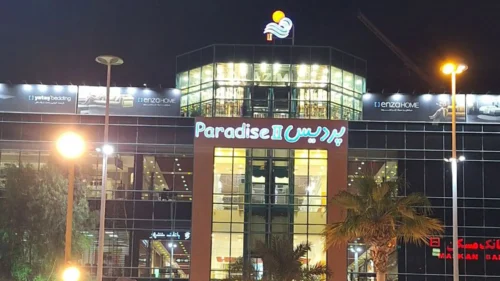
وبلاگ سپهران | Attractions | The Portuguese Castle of Qeshm: A Monument of Resistance in the Heart of the Persian Gulf
The Portuguese Castle of Qeshm stands as a monumental relic of the era of Portuguese colonialism and a symbol of Iranian resistance in the heart of the Persian Gulf. Qeshm Island, the largest island in the Persian Gulf, shines like a green jewel upon the blue expanse of southern Iran. The island is not only unmatched in size, but also embraces an astonishing variety of natural and historical attractions.
Every corner of Qeshm is a living book of nature and history; from the Valley of the Stars, which locals believe was formed by the impact of celestial bodies and is today recognized as one of the world’s unique geoparks, to the mangrove forests of Hara that breathe with the ebb and flow of the tide, serving as a habitat for migratory birds and rare marine species.
Yet among all these wonders, a structure rises on the northern coast of Qeshm—not born of natural marvels, but of history and political and military struggles: the Portuguese Castle.
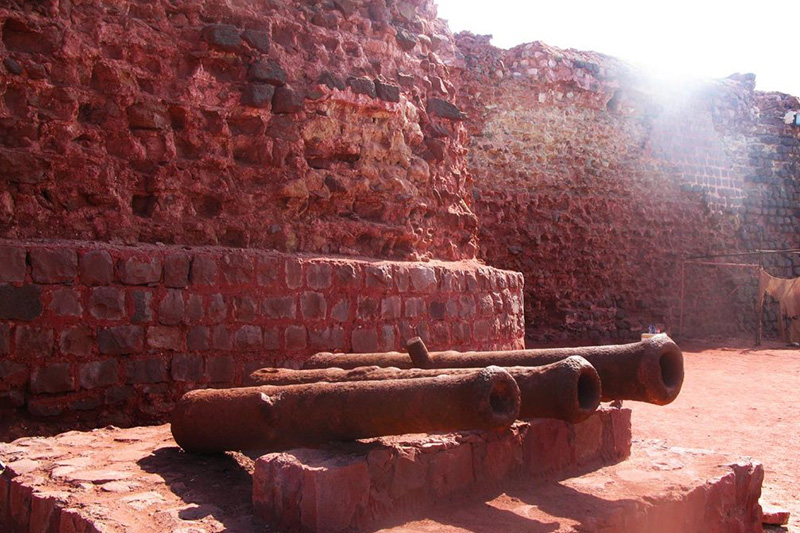
The story of the Portuguese Castle of Qeshm is tied to a name that holds a special place in the history of Portuguese seafaring: Afonso de Albuquerque. This ambitious admiral realized in the early 16th century that any power capable of controlling three key points of the world—namely the Strait of Hormuz in the Persian Gulf, the Gulf of Aden at the entrance of the Red Sea, and the Strait of Malacca in Southeast Asia—would dominate the main routes of global trade. With this vision, he set sail for the southern waters of Iran and, in 1514, occupied Hormuz Island and then Qeshm.
To secure their dominance, the Portuguese began constructing stone fortresses at various points along the Persian Gulf. The Qeshm Castle was one of these strongholds—a massive fortress whose construction took nearly 30 years, eventually becoming their military and commercial headquarters in the region. The tall walls, watchtowers, and surrounding moats of this castle reveal that the Portuguese intended to establish a long-term and lasting presence in southern Iran.
For over a century, this castle stood as a symbol of colonial power. From here, the Portuguese monitored trade routes, imposed heavy taxes, and reaped huge profits from the spice trade, pearls, and Eastern goods. Their presence in Qeshm and other Iranian ports lasted for about 110 years.
But this dominance was not eternal. In 1623, Iranian forces under the command of Imam-Quli Khan of the Safavid dynasty launched an assault on the castle. After a fierce battle, the fortress fell, and the Portuguese flag was taken down. With this victory, Iranians liberated not only Qeshm but the entire Persian Gulf from European colonizers. From then on, the Portuguese Castle lost its military function and gradually faded into obscurity.
Centuries later, in 1999, Iranian archaeologist Ehsan Yaghmaei excavated the remains of this historical monument from beneath the soil. Shortly after, during the digging of electricity channels around the castle, ancient tunnels were discovered—all of which led into the fortress. These secret passages were likely built for moving Soldiers
or commanders to escape during times of siege.
However, the following year, a powerful earthquake in Qeshm inflicted serious damage on the eastern walls of the castle, forcing excavations to halt. Nevertheless, in 2010, the Cultural Heritage Organization of the Qeshm Free Zone took over management of the castle, initiating restoration, reinforcement, and lighting projects.
Today, this monument is registered as No. 2202 on Iran’s National Heritage List and is recognized as one of the most important remnants of colonialism in the south of the country. The Portuguese Castle of Qeshm is not only a symbol of the region’s turbulent past but also a testament to the resilience of a people who, despite all hardships, reclaimed the independence and freedom of their homeland.
One of the advantages of visiting the Portuguese Castle is that it is situated in the heart of Qeshm city, offering a wide range of accommodation options. Whether you are seeking comfort, a local experience, or even outdoor camping, there are various options available.
Hotels: If you prefer to stay close to the castle so that you can reach it within a few minutes on foot or by car, several hotels are located in the northeastern part of Qeshm. Hotels such as Aseman, Apadana, Kavan, Asmari, Nakhl Hengam, Royal, Behesht, Reyhan, Aram, and Alvand 2 are among the nearest options, with the castle usually no more than a five-minute drive away.
Eco-lodges: For travelers who wish to experience the authentic lifestyle of southern Iran, Qeshm’s eco-lodges are the best choice. These accommodations may not offer the luxury of city hotels, but they provide a genuine experience of local hospitality. Lard Suza, Khane Doost, and KaKa Qeshm ecolodge are among the most popular eco-lodges on the island. Although they are about an hour away from the castle, the experience they offer is truly worthwhile.
Rental Houses: If you are looking for a more private space or a budget-friendly option, rental houses and suites are very common in Qeshm. This choice is particularly suitable for families or larger groups, as it gives you more flexibility in scheduling and also reduces accommodation costs.
Camping: For adventurers who want to spend the night under the starry southern sky, pitching a tent near the castle can be an unforgettable experience. The Portuguese Castle Park, located only seven minutes away from the monument, offers a suitable camping space with facilities such as restrooms. Imagine starting your morning with the breathtaking view of the endless Strait of Hormuz right in front of your camp—a rare experience you won’t find just anywhere.
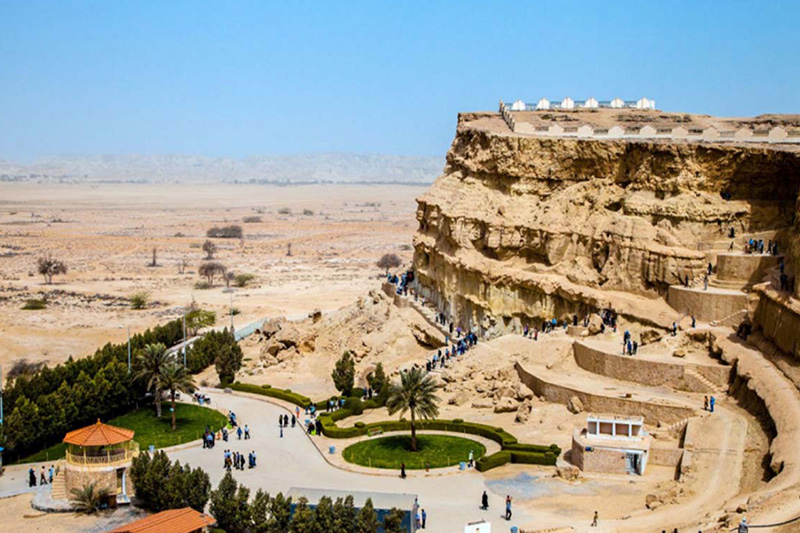
The climate of Qeshm is generally hot and humid, which means that traveling to the island does not offer the same conditions throughout the year. Due to the high humidity and scorching sun, summers in Qeshm are not very suitable for tourism, especially when your destination is the Portuguese Castle, which is located in an open area with limited shade.
However, as soon as you turn the calendar to the cooler months of the year, the experience changes. From late autumn to early spring, the weather in Qeshm becomes more pleasant, and visiting the castle—while strolling through its historic grounds—turns into an unforgettable experience. During this period, the sea breeze adds a refreshing coolness to the atmosphere, allowing you to explore the castle’s courtyard for hours without the discomfort of extreme heat.
If you are among those who find crowds overwhelming, it is recommended to visit Qeshm during January and February. At this time, the island is quieter, giving you the chance to discover the castle in a calmer and more peaceful setting. Conversely, during Nowruz holidays and in the spring season, Qeshm becomes one of the busiest tourist destinations in Iran, and the castle’s grounds are usually filled with visitors.
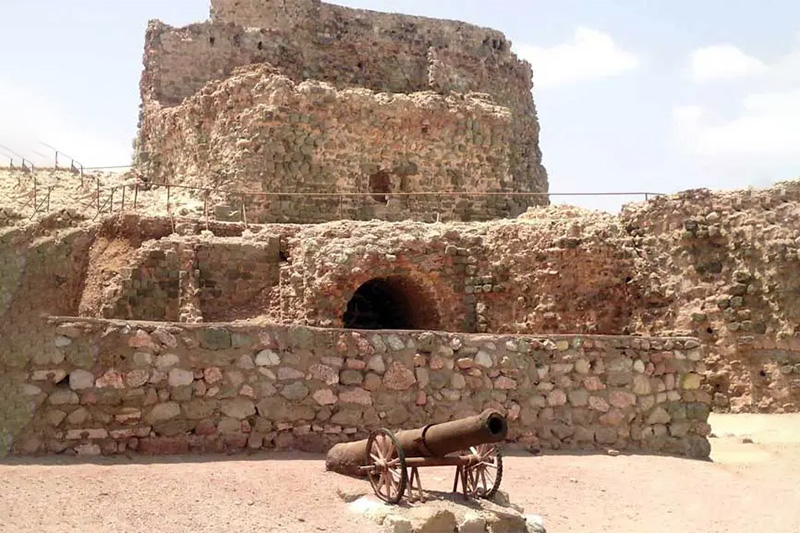
The architecture of the Portuguese Castle is as captivating as its history. Covering an area of about 2,000 square meters, the fortress has an irregular quadrilateral layout, with four corner towers rising twelve meters high. The walls, some up to four meters thick, were built to withstand both time and attack.
The primary materials used were coral stones from the island’s shores, combined with gypsum and a traditional mortar called sarooj, which offered durability against Qeshm’s humid climate. A moat once surrounded the castle, serving both defensive and practical purposes.
Inside the fortress, spaces such as barracks, armories, prisons, cisterns, and even a church were built, turning the castle into a self-sufficient stronghold where Portuguese soldiers could live for months.
Interestingly, parts of the architecture show influences of Iranian design, especially in the water cisterns and arches, suggesting that local builders contributed their knowledge. This blend of European military style and Persian craftsmanship makes the castle unique.
Although parts of the walls have crumbled and the moat is filled in, standing atop the surviving towers and gazing at the Persian Gulf offers visitors a glimpse of the fortress’s former grandeur.
The Portuguese Castle is not merely an architectural monument; it is a living document of a turbulent era when European colonial powers first set foot in the warm waters of the Persian Gulf. The Portuguese, with their mighty fleets, sailed thousands of kilometers from Lisbon to seize control of the Eastern trade routes. They came to Hormuz, occupied Qeshm, and built a fortress that was meant, in appearance, to rule this vital waterway forever. But history tells another story. Despite its formidable structure, the Castle could not withstand the determination of the Iranian people. Visiting the Portuguese Castle of Qeshm is, in fact, a walk along a passageway between past and present.
On one side, you can witness the grandeur of military architecture from centuries past, and on the other, behold the boundless horizon of the Persian Gulf, still just as majestic. This Castle reminds us of a profound truth, Qeshm is not only an island for admiring unspoiled nature; it is also an island where every inch of soil carries deep history and identity.
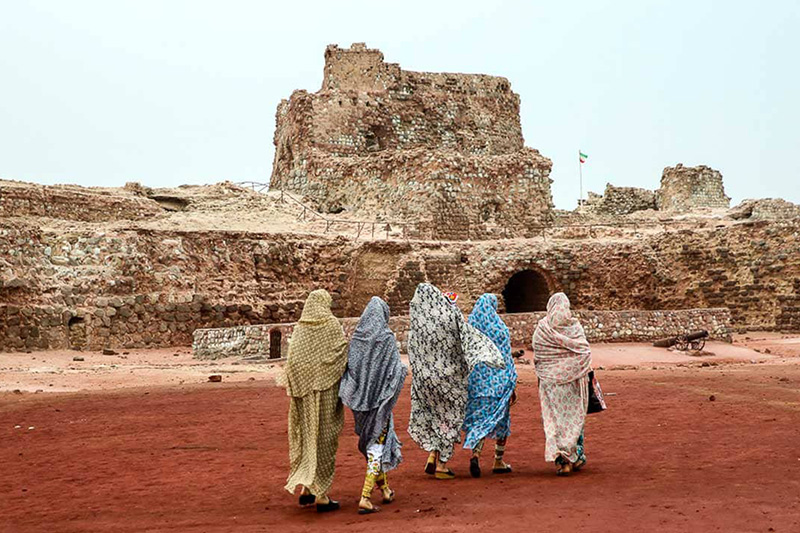
The Portuguese Castle is an accessible attraction suitable for almost everyone. The pathways are mostly level, making it manageable even for families with children or elderly visitors.
However, climbing the towers and uneven stone steps requires some physical ability and caution. For history lovers, each wall is a page in a living chronicle of resistance and colonial ambition. For photographers, the interplay of light and shadow on the stone, especially during sunset over the Gulf, provides breathtaking scenes.
In short, the castle appeals to families, friends, history enthusiasts, adventurers, and photographers alike. All you need is comfortable shoes and a sense of curiosity.
Visiting the Portuguese Castle of Qeshm does not require complex equipment or special gear, but having a few simple items can make your experience much more enjoyable. The castle grounds are generally flat, and walking around is not very difficult; however, wearing comfortable walking shoes will help you explore the stone walls without getting tired.
Since the visit usually takes between one to two hours, carrying a bottle of water and a light snack—especially if you are accompanied by children or the elderly—will be very useful. The southern sun of Iran is no joke; therefore, sunscreen, a wide-brimmed hat, and sunglasses are essential for your trip.
In the hotter seasons, having a handheld fan or a cooling towel can also make your experience more comfortable. And finally, do not forget a camera or a fully charged phone, as they will be your best companions for capturing the unforgettable sunset views from the castle’s towers.
The Portuguese Castle itself is more of a historical monument than a place equipped with modern facilities; therefore, once you enter the site, you will see nothing but thick walls, towers, and centuries-old remains. This very simplicity is part of its charm, as it takes you back in time by several centuries.
However, the castle’s location in the heart of Qeshm city means you won’t face any shortage of amenities nearby. Just a few minutes walk will take you to local and seafood restaurants, traditional ice cream shops, hypermarkets, city parks, mosques, and even hotels. The presence of banks and large stores close to the castle has also made the visit easier for tourists. For this reason, you can explore this historical site without any concern about the availability of facilities.
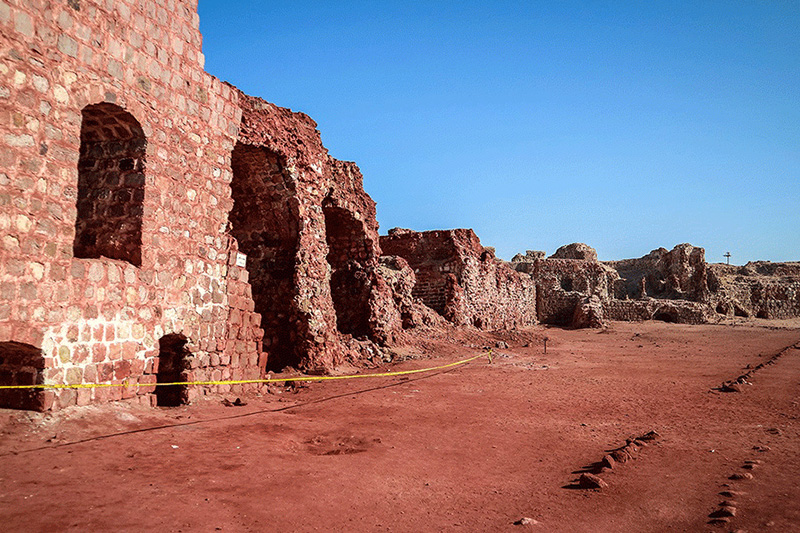
Entering the Portuguese Castle requires purchasing a ticket, with different rates for Iranian and foreign visitors. Although the ticket price is not very high, the collected fees are allocated to the maintenance, restoration, and protection of this historical monument.
Visiting hours are usually set from 8 a.m. to 6 p.m., a time when daylight ensures safe conditions for exploring. On average, visitors spend between one to two hours inside the castle—enough time to see the walls, towers, inner courtyard, and capture photographs of the endless views of the Persian Gulf.
For those interested in professional photography, it is recommended to plan their visit around late afternoon and sunset, as the golden light of the sun reflecting on the coral stones of the structure creates a dreamy and unique atmosphere.
The Portuguese Castle of Qeshm is not just an abandoned military fort; within its thick walls lie secrets, each opening a new window into the past.
Silent Cannons of History: Scattered around the grounds, a few iron cannons can still be seen—artillery pieces that once sent thunderous blasts shaking enemy ships. Over time, many of these weapons were relocated to different parts of Qeshm, yet the remaining few still remind visitors of the turbulent days of battle in the Persian Gulf.
Mysterious Underground Passages: Beneath the visitor’s feet lies a hidden network of tunnels, some of which have been discovered and studied by archaeologists. It is said that these secret routes once stretched as far as Saadi Square in Qeshm, with some sources estimating their length at up to 15 kilometers. Such tunnels were likely used by commanders to escape or to transport supplies and ammunition during times of siege.
Marks and Symbols on the Walls: The past is not only preserved in the cannons and towers; on some of the castle’s walls, traces of paintings and designs can be seen, left behind later by local residents. Although simple and primitive, these artistic marks show that the castle continued to be a part of the lives of Qeshm’s people even after its military role ended, adding another cultural layer to the island’s history.
These three secrets are only a small part of the untold stories of the castle. Every brick and every stone may carry narratives still waiting to be discovered.
The Portuguese Castle of Qeshm is not merely a historical structure; it is a living chronicle of the Persian Gulf and the people of Iran. Its thick walls and steadfast towers stand as testimony to a time when European colonizers dreamed of dominating global trade, yet ultimately failed against the resistance of the Iranians.
In fact, the Portuguese Castle of Qeshm is one of the island’s most important historical attractions. With its massive walls and majestic towers, it vividly illustrates the era of colonial presence in the Persian Gulf. If you are planning to see this centuries-old monument up close, the first step is to book a flight ticket to Qeshm. Visiting the castle is an inseparable part of the trip. By reading the Qeshm Travel Guide, you can embark on this exciting journey with peace of mind—because beyond its unique architecture, the castle offers breathtaking views of the turquoise waters of the Persian Gulf and an unforgettable encounter with the history and culture of southern Iran.
Today, the castle is no longer a military fortress, but rather an open-air museum of history that transports visitors back to the 16th century. A trip to Qeshm will not be complete without visiting this remarkable site.